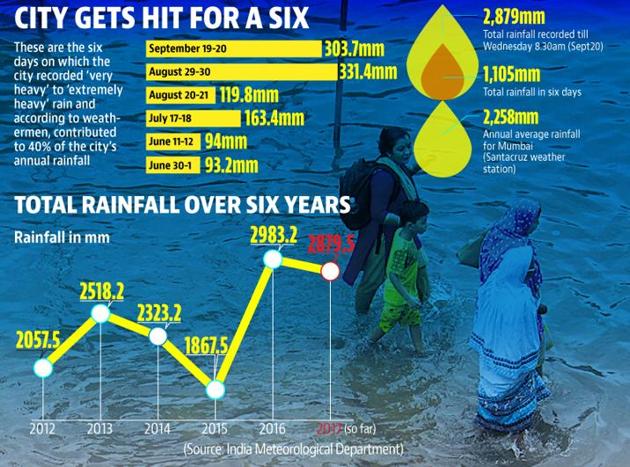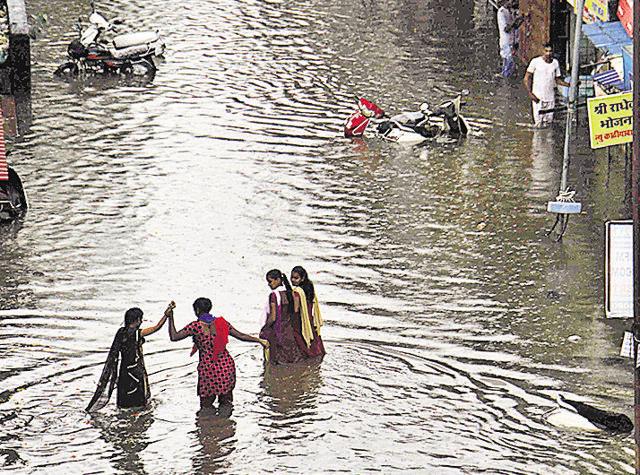Mumbai’s rains they are a changin’: Six days accounted for 40% of city’s rain this year
Experts say recent monsoons saw few days of intense downpour contributing to almost half of the city’s annual rainfall and that this could be the pattern now on
The rains are not the same anymore. In recent years, instead of the monsoon being more or less evenly distributed across four months, the city saw a few days of intense rain that contributed to almost half the city’s annual rainfall, according to experts. This, they said, could be the monsoon pattern from now on, which means Mumbai may become prone to floods.

This monsoon, just six days of ‘very heavy’ to ‘extremely heavy’ rain contributed to 40% of the city’s rainfall so far.
Mumbai received 303.7 mm — the highest 24-hour average for a September day in ten years — between 8.30am on September 19 and 8.30am on September 20. During the same duration between August 29 and 30, the city got 331.4mm. It rained 163.4mm between July 17 and 18.
There was one day in August and two in June when the city received nearly 100 mm in 24 hours (see graphic). The total rain on these six days was 1,105mm. The total rainfall this season was 2,879.5mm (from June 1). If Mumbai’s historical annual average rainfall of 2,258 mm is considered, the 1,105mm received in these six days is almost 50% of its yearly rain. Monsoon in Mumbai is generally from June to September.

While the city has been surpassing its annual average in recent years, extreme rainfall events have increased only recently, said experts. “What we witness today is a significant rise in rainfall intensity during monsoon months, especially in coastal cities like Mumbai, but the frequency of rain is not increasing,” said DS Pai, head, climate prediction division, Indian Meteorological Department (IMD), who conducted a study an extreme rainfall events across the country and had identified Mumbai as one of the urban cities where rainfall intensity would increase. “Owing to the rising intensity, urban cities such as Mumbai are susceptible to flooding.”
“Several observations have already shown that heavy-rainfall events are on the rise. It has also been observed that some of the cyclonic storms are also getting intensified owing to the same mechanism. The theoretical explanation for this conforms to the climate change theory and there is no point in arguing that there could be other causes to this,” said Biswajit Mukhopadhyay, former additional director, India Meteorological Department (IMD).
Researchers from private weather forecasting agency Skymet attributed the rise in extreme rainfall events — more than 204.5mm in 24 hours (IMD) — to increasing environmental degradation. “The fact that Mumbai could record 300mm rain in 24 hours, twice in a month, has not been witnessed in previous years. It clearly shows that extreme climate events are increasing every year owing to rise in global temperatures, depleting green cover and ecological destruction,” said Mahesh Palawat, vice president, meteorology, Skymet. “The amount of rainfall being recorded within 6-8 hours now is equal to the quantum recorded over a month by coastal cities like Mumbai.”
Officials from the IMD said the rise in extreme rainfall events was not confined to coastal cities like Mumbai but has become a worldwide phenomenon owing to global warming. “From 1901 to early 2017, there has been an average rise in global temperatures at 1.04 degree Celsius. In India this increase is at 0.8 degrees Celsius but still the impact of warming is visible,” said Dr KJ Ramesh, director-general, IMD. “The rise in temperatures has increased the moisture-holding capacity in the atmosphere and leading to a change in water cycle. Thus, during monsoon months, the change in pattern is visible through rise in rainfall intensity.”
Pai said that a more detailed study of monsoon patterns over the next four years can establish whether these extreme rainfall events can be attributed to climate change.
A 2006 study by Pune-based Indian Institute of Tropical Meteorology led by BN Goswami showed that from 1950 to 2000, the incidents of heavy and very heavy rainfall events (more than 100 mm/day and 150mm/day respectively) increased while the moderate events (less than 100mm/day) decreased.



